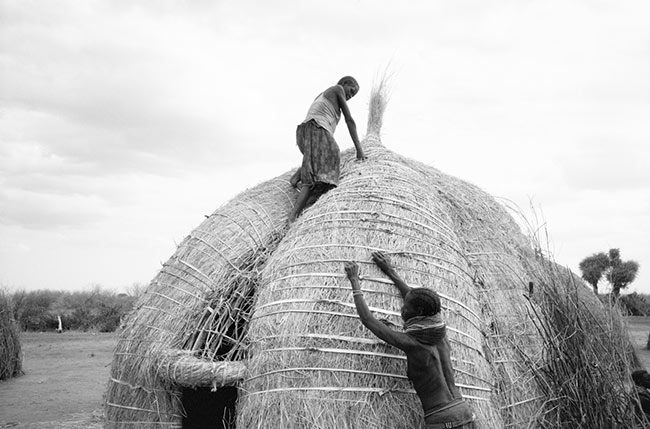On the Architecture of the Nyangatom People
Interview with Lyan Losekona by Winfried Bullinger
Biography
Lyan Losekona was born in 1987 in Kibish in the South Omo region, to a family of pastoralists, according to the Ethiopian calendar (1995 according to the Gregorian calendar). His name in Nyangatom society is Longolio. Kibish is located on the river of the same name, which forms the border between Ethiopia and South Sudan. Lyan belongs to the Nyangatom people. He lived as a shepherd with his family in Kibish from the age of ten until he was seventeen. He left his life as a cattle herder to go to school, against the wishes of his family. From 2008, he attended primary school in Kangaten, the main town of the Nyangatom on the Omo River. From 2018, he attended Jinka Secondary School for two years and is now studying at the university in Mizan Tepi. He works as a local guide and is trusted by the local communities. Lyan and Winfried have known each other since 2012.
Interview
Winfried: The structures of the Nyangatom are striking. You can immediately recognise a village as a Nyangatom village.
Lyan: That’s really true. When you see the granaries and houses from a distance with their pointed tops, you can tell that they are Nyangatom structures. The structures of the Nyangatom have a unique shape and style in the Omo Valley.
Winfried: Can you say something about the different types of structures in a village?
Lyan: In every village, there are residential buildings, granaries, stables for livestock, and constructions designed to provide shade.
The construction of the residential buildings is primarily functional. They provide good ventilation and protection for the interior during heavy rain.
The granaries are raised on wooden stilts to protect the grain from rodents and moisture, for example. The Nyangatom are farmers and grow the grain they store in the granaries themselves. Crops are planted during the rainy season, when the Omo is flooded and the banks are irrigated. During this fertile period, the Nyangatom grow sorghum, corn and beans.
The roof structures that provide shade are open at the sides. They serve as a meeting place for the village elders and are only used by men. Occasionally, village meetings are also held there. In 2017, the two of us took a photograph of such a ‘shade’ near Kibish in the border area with South Sudan.
The stables for the cattle are built near the entrance gate to the village, along the fence. In the middle is the hut where the animals are kept.
Winfried: We camped next to a stable and watched as the whole family took care of the animals.
Lyan: The animals play a major role in our lives. Livestock forms the economic basis of the Nyangatom, who are primarily pastoralists. They are a source of food and at the same time ensure the prosperity of the families. The Nyangatom keep cattle and goats. Goats are particularly good at surviving in the dry and hot area. Donkeys serve as pack animals.
Winfried: What objects are part of the furnishings of residential buildings?
Lyan: There are many objects in the house that belong to the traditional furnishings: cooking utensils such as gourds, gourd cups for storing milk, cowhides for sleeping on, shelves for storing gourds and local spoons made of wood. There is also a supporting structure inside the hut. A rug made of branches is also part of the furnishings, protecting the cowhide from dust.
Winfried: Are there fires in the houses, and where do they cook?
Lyan: Fireplaces are located both inside and outside the hut. Since the climate in the region is harsh, the Nyangatom cook inside the hut during the rainy season and outside the hut during the dry season.
Winfried: How big are the villages? How many houses do the families who live there have?
Lyan: The permanent villages of the Nyangatom can reach a considerable size. It depends on the number of families and households in the village. In very large villages, there can be up to fifty families. In the Nyangatom tribe, the same family can have more than three houses. This is because in Nyangatom society, polygyny is practised and a man can have more than three wives, and each wife has her own house. The size of the family in Nyangatom can be large, medium or very large, depending on the number of children each woman has.
Winfried: Who has the knowledge of how to build a house, for example, in the Nyangatom community? I have seen that it is mainly women who build the houses. How do the villagers work together?
Lyan: Yes, it is the women who have the knowledge of how to build the houses, granaries and other buildings in the villages. The women construct the buildings in a cooperative manner. Several women help each other and, for example, can finish a house in just a few days. But it is also rare for a woman to build a structure alone. That would take a long time.
Winfried: How long do the Nyangatom use a structure? How long does it last?
Lyan: The lifespan of a structure depends on the materials the house is made of. A residential house and a granary can last for four to six years before they are replaced by new buildings. For example, one of your pictures shows a newly built granary that is about two months old. The huts in the background, on the other hand, are four to six years old.
Winfried: I find it fascinating that the buildings are replaced after a few years and rebuilt again and again in the same style. The new old. Do you have any knowledge about the roots of the architecture?
Lyan: Well, the traditional architectural style of the Nyangatom is not new, but it is one of the oldest elements of our culture. The original inhabitants of the region have preserved it over the centuries and never forgotten it.
When I was in the village, the old people told me many things, but I didn’t hear anything about a change in architectural style. The style and the construction method are consistent, even if the buildings are repeatedly replaced by new ones. The knowledge of our traditional architecture thus extends far back into the past. It is passed down from generation to generation.
In our tribe, the past is of great importance for our culture. The division into clans, the way of life with its customs, elements of nature religion and even the architectural style have retained their significance for the young generation.
Winfried: The Nyangatom buildings are made of materials found locally in nature. When a building is no longer used, nature is not burdened by ruins. Can you say something about the use of these traditional materials? How are they collected?
Lyan: Traditional, locally available building materials have the advantage that the cost of building the huts is zero. Every family can afford a house. Other advantages are that the traditional materials promote air circulation in the houses and therefore have a cooling effect. They help people to withstand the local climate, the heat and the winds. The women collect the building materials in the forest.
Winfried: Are old materials reused when a new building is constructed after a move? What value do the wooden poles used to build the huts have, for example?
Lyan: The old materials are really reused when the new houses are built. Even if the old location is abandoned and the village moves, the residents take the building materials with them and reuse them. The materials can be flexibly assembled, dismantled and moved. The design of the buildings can easily be adapted to the location.
The wooden poles are of particular importance and value for the construction of the houses and granaries. They must be of good quality. They support the structures and should last for many years. They ensure that a hut does not collapse in strong winds. The wooden poles also shape the beautiful design of the buildings.
Winfried: How do the Nyangatom develop their settlement area? I noticed that the villages are often close to each other.
Lyan: The Nyangatom build their villages in an environment that is well suited for life. The decisive factor for the location of the villages is that the land provides the necessary resources such as water and plants. When good natural conditions are present, the Nyangatom build their villages close together. Suitable land is rare where we live.
Winfried: I would like to talk to you about nomadism and architecture. How do permanently inhabited villages differ from the temporary camps used during the migration?
Lyan: All permanent Nyangatom villages have a fence made of thorny scrub with entrances that can be closed at night. That’s how you can recognise them. The fences protect the permanent villages. Yes, there is a special architecture for temporary, short stays. Unprotected huts are only occupied for a short time. There are also simple camps that are set up for only one or two nights during a hike. The huts in these camps are less carefully and quickly built. During migration, the herders also use old camps from previous hikes that have been empty in the meantime.
Winfried: Do entire villages move?
Lyan: The Nyangatom sometimes live in a village for a little over ten years before moving. The village moves as a community. The new village is often built near the old village. Sometimes the community decides to move over a greater distance. A change in climate may be the reason for moving to a more fertile area further away.
Winfried: In January 2017, we met a village community on the border with South Sudan that was moving. Do you remember?
Lyan: Yes, we saw that an entire village had been moved near the Kibish River. The villagers transported their belongings on donkeys. Nomadism is a feature of the Nyangatom’s lifestyle, to get water easily and to adapt to the environment. During the dry season, they move near rivers. Also to get good shade, because the trees grow near the river. The banks are always green and the inhabitants have fresh air.
Winfried: You told me that climate change has had a significant impact on the Nyangatom area in recent years. Is climate change affecting the durability of traditional buildings? What influence does it have?
Lyan: That’s right, I told you about it at our meetings. Climate change has occurred and is still happening. But it does not change the form of our traditional buildings and structures. Our buildings are very durable and withstand the changing weather. However, the relocation behaviour adapts to climate change. The increasing droughts lead to a loss of grass and water. They threaten our livestock. The search for fertile areas during the migration is becoming more difficult.
Winfried: How close are the contacts between the different villages?
Lyan: There are close links between the Nyangatom villages. A kind of networking takes place. During the migration, Nyangatom men and women can visit other Nyangatom villages at any time and also stay overnight there. Information is exchanged between the villages. This is part of the Nyangatom’s lifestyle as cattle herders. For example, the Nyangatom women of different villages keep in touch, help each other or meet up just for fun.
Winfried: How long does a migration of the shepherds with livestock take? How far away from the village do they leave? How many times a year do the migrations take place?
Lyan: A migration of the shepherds with their animals takes several months. The nomadic practice takes place twice a year. Once a year, the Nyangatom move with their cattle towards the Omo National Park. The second migration each year takes them to the south of the Nyangatom area, to the foot of the Kuraz mountain. During the migrations, the herders move between 60 and 90 kilometres away from their permanent villages. They return when enough grass has grown around the villages during the rainy season.
Winfried: Can you tell us something about your experiences when you were a shepherd yourself?
Lyan: Yes, I took part in the migrations from Kibish with the cattle in the direction of the Omo National Park. We were looking for grass and water. That was during the dry season; during the rainy season I lived in Kibish.
Winfried: In July 2013, we took a dugout canoe on the Omo River in the morning. I still remember the many crocodiles in the river. We met a group of herders on the banks of the Omo River with their herd of goats. The herders were all armed with assault rifles. Are there cattle thefts and conflicts?
Lyan: And yes, there is cattle raiding and theft. Most of the time these incidents happen as acts of revenge among us Nyangatom. But there are also conflicts with other tribes, including the Suri, the Mursi, the Turkana and the Dasanesh. Raids usually occur during the day in the grazing areas. There have also been changes. The Suri and Turkana increasingly began to steal cattle at night, when we were already asleep. The other tribes learned of these nocturnal attacks by the Suri and Turkana and took revenge.
Winfried: In the traditional villages of the Nyangatom, more and more huts and stores are being built in the Toposa style. It seems as if the exchange between peoples has increased.
Lyan: And yes, there is an increasing exchange between Nyangatom and Toposa in terms of architecture.
The reciprocal visits between these groups have become more frequent. Half of the Nyangatom live in South Sudan in the same area as the Toposa. So the contact between Nyangatom and Toposa is close. The rules give visitors from the other country three weeks to stay and a maximum of one month. Nyangatom and Toposa visit each other as friends, sometimes by invitation. In addition, the Toposa visit the Nyangatom area to see their own family, who originally came from Kapoeta and now live in Ethiopia. Many Toposa also stay with us permanently.
As we have seen during our visits to villages, some Nyangatom villages now have buildings in the style of both peoples. In the village of my relatives, where we camped, this was the case, for example. The construction of the house roofs with graded layers of grass, which belongs to the style of the Toposa, and the construction without layers, which belongs to the style of the Nyangatom, can be found side by side in the village. So in the Omo Valley, architecture of the Nyangatom and the Toposa can be found.
Winfried: In 2018, we visited a temporary Toposa camp near Kangaten together. The residents said that the entire village community had left South Sudan. They came from the Kapoeta region. We took the pictures of the huts under the trees during a second visit in the morning light. Later in the day they were in the shade.
Lyan: Toposa groups have left South Sudan because of the situation there, for example, because of inadequate health care. The village, which we visited twice in 2018, consisted of emergency shelters that the residents themselves built from branches and plastic tarpaulins.
However, the dwellings were only intended for a temporary stay and were located under the trees near the Omo River for protection. The inhabitants later left the provisional camp to settle permanently in the region.
Winfried: The Nyangatom territory has changed since we first met. The villages of Kangaten and Kibish have grown. There is a bridge over the Omo River, an ‘all weather road’ and a mobile phone network.
Lyan: The Nyangatom are very adaptive. They quickly adopt new things, for example from the Toposa in South Sudan. Today we live in the neighbourhood of the Toposa, not only in South Sudan but also in Ethiopia. From them, for example, we have adopted the newer method of building houses. This also uses clay and cow dung.



